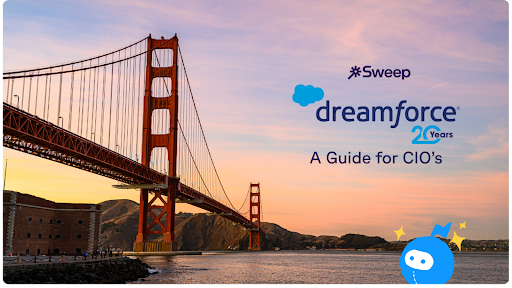For CIOs, Dreamforce is like the World Series of enterprise transformation.
Except, with hundreds of sessions, countless vendor pitches, and an overwhelming expo floor, it is easy to leave with more swag (say, stress balls) than strategy.
This Dreamforce 2025 prep guide is aimed at helping CIOs arrive prepared, evaluate tech partners effectively, and leave California with next steps that will drive real organizational value.
Define your North Star before you land in San Francisco
Many CIOs — perhaps too many — arrive at Dreamforce without a clear framework for what matters most to their org. Before you even step into Moscone, ask yourself:
- What are my top 2–3 business imperatives this year? (for example, scaling AI responsibly, consolidating platforms, improving data governance)
- What Salesforce-related initiatives are at the top of our IT roadmap? (for example, revenue operations alignment, customer data unification, service automation)
- Where are we experiencing friction? (for example, slow time-to-market, high cost of Salesforce customization, lack of visibility for ops teams)
Evaluate vendors with an enterprise lens
The expo floor is a dazzling circus of novelty, but CIOs need to quickly separate shiny demos from solutions that actually deliver enterprise value. When evaluating vendors: Check integration maturity: how natively does the solution work with Salesforce metadata? Does it extend the platform or create shadow systems?
You should also look for scalability proof points: can the solution handle global complexity such as territories, multi-object routing, and governance without brittle custom code?
While you’re at it, ask about compliance and security: is the vendor SOC2 compliant? How do they handle audit trails, permissions, and metadata versioning? Demand real customer evidence: do they have reference stories in orgs of your size and complexity? Can they show quantifiable ROI such as time saved, cost reduced, or risk mitigated?
A clear understanding of total cost of ownership helps too: beyond licensing, what is the admin and maintenance cost? How long does implementation actually take?
Questions you should bring to Dreamforce this year
When meeting with vendors, come armed with targeted questions that cut past the marketing veneer. Here are some to keep in your pocket:
Strategic fit
How does your solution align with Salesforce’s metadata-driven architecture and roadmap for AI?
What differentiates you from other vendors in this category?
Scalability and security
How does your platform scale with org growth, territory changes, and multi-cloud deployments?
What governance features are built-in such as audit trails, rollback, and metadata documentation?
Operational impact
How do you reduce IT dependency and empower business teams to make changes safely?
Can you show a customer example of reducing time-to-implement from weeks to days through smarter use of metadata?
How can human operators and metadata agents work together to ensure Salesforce evolution?
Future-proofing
How does your product evolve with Salesforce metadata updates and new AI capabilities?
What is on your product roadmap for the next 12–18 months?
Tactics for making the most of Dreamforce 2025
There’s a lot more in San Fran than you could possibly tackle. We recommend prioritizing sessions by role: attend CIO roundtables, AI strategy sessions, and customer transformation keynotes, not just product showcases. Block time for vendor meetings: schedule conversations in advance with your shortlist of potential partners. Next, bring your team into the fold: if your RevOps or IT leaders are attending, align on who is covering what sessions and vendors. Plan for follow-up: book internal debrief sessions post-event to evaluate vendors and align on next steps.
The big takeaway for CIOs
Dreamforce is a marathon, not a sprint. With the right prep, it can be the spark for real enterprise transformation instead of just another busy week in San Francisco. Come in with a clear north star, a framework for evaluating vendors, and sharp questions, and you’ll walk away with a plan that sticks.
Pro tip: many of the most innovative Salesforce apps today are metadata-first, using metadata as the connective tissue between AI, automation, and governance. As you explore vendors, look for those who do not just work in Salesforce, but who make your metadata cleaner, more accessible, and more powerful over time. Metadata agents give you a strategic edge and predictable growth. Leaders who embrace them become pioneers who deliver true AI transformation.
Why Sweep should be on your shortlist
Sweep was built with CIOs in mind: a metadata-native Salesforce layer that eliminates complexity, reduces IT dependency, and ensures governance without slowing down business teams. With capabilities like AI-powered routing, real-time testing, deduplication, and audit trails, all embedded in Salesforce, Sweep gives CIOs the visibility and control they need while freeing operations to move faster.
If you are walking the expo floor at Dreamforce 2025, look for vendors who make your metadata work harder for you. And when you do, make sure Sweep is at the top of that list.

